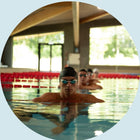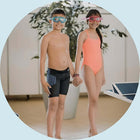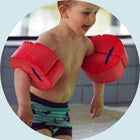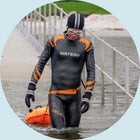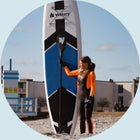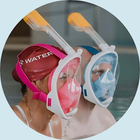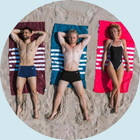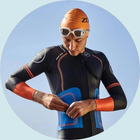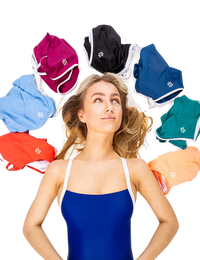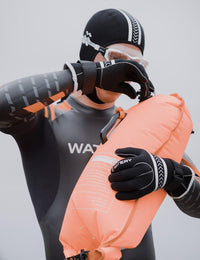Here at Watery, we're diving into a theme article on Open Water Swimming, aimed at exploring the experiences you might encounter. We'll also highlight key safety tips to help prevent accidents, given the inherent risks associated with any time spent in water.

Our article series covers:
- The Gear Jungle: Essential Equipment for Every Open Water Swimmer.
- How to Best Prepare for Open Water Swimming.
- 5 Guidelines for Open Water Swimming: Achieve Maximum Safety in the Water.
- How to Avoid Unpleasant Situations in the Water.
- Open Water Swim Training.
Open Water Swimming – Equipment
Choosing equipment for open water swimming can be quite a science. Should your goggles be polarized or not, is 5mm neoprene around the shoulders too much in your wetsuit, and how do you best care for your newly purchased gear? We’ll share some tips and tricks based on our own experiences.
When packing your bag for a swim, at a minimum, it should include:
- A piece of regular swimwear – either a swimsuit or swim trunks - to wear under your wetsuit.
- A wetsuit (optional in warm water, but recommended up to 20-22 degrees, as the wetsuit not only keeps you warm but also enhances your safety and buoyancy in the water).
- Swim goggles for open water (type depending on the weather).
- Swim cap (Choose from a variety of colors, preferably green, red, yellow, and orange, but avoid black, gray, and navy as they're less visible in the water).
- Safety Buoy – a colorful inflatable buoy that you attach around your waist. These typically double as a sea bag, allowing you to carry keys, phones, and similar items.
- Towel or bathing poncho - it’s nice to wrap up warmly after a swim.
- Vaseline/oil – Used for applying underarms and neck to prevent chafing, especially in saltwater.
- Earplugs for swimming – Cold water in your ears can cause quite a headache.
When it comes to wetsuits and swim goggles, there are a few things to keep in mind. For wetsuits, it's wise to try it on before purchasing, especially if returning it by mail isn't easy. The first time you wear it, the suit should feel snug because neoprene loosens with use. It shouldn't be loose under the arms or around the crotch as water filling these spaces will cause the suit to be less warm, swift, and comfortable. Look for wetsuits with panels of varying thickness—5mm on the chest and thighs for buoyancy and warmth, while 3mm on arms and legs, and 2mm around the shoulders ensure good movement. If you plan to do some underwater exploring, a good snorkel set could also be a valuable addition to your gear.
Regarding goggles, a look outside can be your best guide. If the weather is cloudy and dim, there’s no point in wearing mirrored goggles. In such weather, swim goggles with clear lenses are preferable. On bright sunny days, mirrored goggles are almost a must. If you're a gear enthusiast, polarized mirrored swim goggles are likely the best choice. The polarized lenses block horizontal light rays (glare from the water), making it easier to navigate in the water.
It's especially important to rinse your gear after swimming in freshwater to remove salt, sand, seaweed, and algae. Hang your equipment to dry, preferably in the shade, as sunlight deteriorates neoprene, rubber, and plastic. Hang the wetsuit inside out initially until nearly dry, then reverse it to dry the outside too.
We hope to shed some light on the equipment jungle associated with most sports. If not, or if you have further questions, you are more than welcome to contact us.
The discount code can be used by all new customers on all products on the website, including the products recommended here in the article. What are you waiting for? Get more out of your time in and on the water!
GET A DISCOUNT CODE WITH 10% OFF
Open Water Swimming – Preparation
"Swimming is just swimming," as the saying goes. Without intending to scare anyone away, one difference is the increased risk you face when swimming in an open area. It's a factor you need to be aware of.
If you plan to prepare for an open water event or just want to train outdoors, it's a great idea to refine your skills in a swimming pool first. Here at Watery, we've compiled a list of skills we find most essential:
- Be comfortable during your swim. Try to develop a relaxed swimming style to avoid wasting unnecessary energy.
- Learn more than one stroke. Most people swim freestyle in open water, but practice either breaststroke or backstroke before heading into the sea so you can switch strokes when tired.
- Swim longer distances in the pool. Most open water events exceed a kilometer, so you should be comfortable swimming that distance in the pool without breaks.
- Learn to tread water. In a pool, you can always touch the bottom when tired. This isn't always possible outdoors. Practice treading water so you can rest your arms during events/training in open water.
- Practice breathing on both sides while swimming freestyle. In open water, you might have to breathe on your "weaker" side due to waves.
- Group swimming. At the start of open water races, swimmers are typically close together. Practice swimming in larger and smaller groups so it's not a shock.
By practicing these skills before your first open water event or training session, we guarantee you'll have a better experience than if you don't.
Open Water Swimming – Safety
Open water swimming can bring immense joy to those who take the plunge. It offers a delightful blend of exercise and breathtaking nature experiences. However, it requires that safety is assured, and there are a set of "rules" that should always be followed.
Guidelines for Open Water Swimming:
- Never swim or train alone. It can be life-threatening if something goes wrong.
- Prepare by training in a pool first.
- Make sure to be visible! Bright swim caps and especially a safety buoy (Open water safety buoy) are great ideas.
- Avoid boat lanes and other heavily trafficked areas on the water. You appear small if a motorboat suddenly appears.
- Get familiar with local currents and weather conditions before diving into the waves.
This infographic from Katoni.dk illustrates these guidelines well (and more).
Additionally, swimming along the coast is recommended, ensuring you never strays too far from the shoreline, so you can easily return. If you'd like more safety tips for water, TrygFonden offers ongoing advice through their campaign Respect for Water.
4.76/5
Based on 25 reviews

Watery Combo snorkel set for adults - Hudson Full-dry - Black
Open Water Swimming – Avoiding Unpleasant Situations
The most uncomfortable experience for an open water swimmer is feeling unsafe or in danger while swimming. We've already tried to avoid these unpleasant situations by training in the pool beforehand and taking safety precautions before hitting the water. In this section, we'll provide some tips to avoid less critical discomforts, ensuring a pleasant swimming experience.
Cold Water – In open water, there's no heater to keep temperatures at a constant 26-27 degrees as in a pool. The water in Danish waters rarely exceeds 20 degrees, so it's beneficial to acclimate to cold water. Everyone knows the instinctive reaction to cold water: quickly inhaling, starting to hyperventilate, and tensing up the whole body. This is not the reaction you want before swimming. Try to relax and feel the water pressing on the wetsuit, noticing where it seeps into the suit, as it inevitably will. Keep your breathing controlled and relaxed. After about a minute, once relaxed, you can start swimming.
Energy Allocation – As in all endurance sports, managing your energy is crucial in open water swimming. Although you might want to start fast, especially if you’re cold, it often pays off to begin the first few minutes of your training or competition at a controlled pace. Otherwise, you create an oxygen debt that can’t be repaid until you slow down enough to remove the accumulated waste in your muscles.
Training with a Wetsuit – If planning to swim an open water event, we recommend getting as much swim time in your wetsuit as possible, both indoors and outdoors. This is because the neoprene around your joints, especially shoulders, restricts your movement. More energy is needed to swing your arms around. This increased effort isn't an issue at first but eventually causes fatigue, and your technique breaks down. This can be prevented by getting used to the exertion through training in the wetsuit, swimming with hand paddles, adding resistance (more on this in the next theme series installment), and performing injury-preventive shoulder exercises with weights or bands.
Chafing – is one of the major nuisances after a swim in your wetsuit. Luckily, it can be minimized by applying Vaseline or especially open water cream/stick around the neck, under the arms, and wherever you experience irritation. If your wetsuit fits properly, you can swim shorter distances without significant issues, but particularly long swims and saltwater sessions can lead to serious chafing.
Jellyfish – If you have the luxury of choosing between different training spots, we recommend (for a better experience) selecting an area with onshore wind rather than offshore wind. Offshore winds push warm surface water away, bringing colder water closer to shore and often along with jellyfish. Moreover, swimming with onshore wind is safer, reducing the risk of being pulled away from shore.
We hope these thoughts and tips assist in enhancing your water adventures. Join us next Tuesday for specific training program suggestions for open water swimmers of various levels.
Open Water Swimming - Training
We've created two weekly plans, each with three workout sessions, aiming to either complete your first open water event (2500m) or swim a fast 5000m. The days listed are flexible, but we recommend having at least a day's rest between each session.
In our training programs, we've used some abbreviations like p.30 which means a 30-second pause. If the programs are unclear, please contact us for clarification.
Complete 2500m:
Monday/Tuesday: High Intensity
200m freestyle p.15
100m kick p.15
200m freestyle p.15
100m backstroke p.15
4x50m progressively 1-4 with a good pause; there should be a noticeable difference between the four 50 meters.
3 rounds of:
200m freestyle at a relaxed pace (30 seconds pause)
100m freestyle at a hard pace (30 seconds pause)
50m freestyle as fast as possible (15 seconds pause)
50m backstroke + 1 minute pause
200m (50% freestyle, 50% backstroke)
(2200m)
Wednesday/Thursday: Sprint and Technique
15-minute warm-up of your choice
2 rounds of:
4x25m freestyle – 25m right arm, 25m left
50m freestyle with fists
100m freestyle – focus on long strokes
5x100m freestyle p.30 at an easy hard pace but focusing more on maintaining good technique than speed.
3 rounds of:
50m freestyle hard pace p.15
25m all-out p.20
25m easy swimming p.30
200m cool down with excellent technique.
(approx. 2000m)
Saturday: Distance Training
5x100m Alternating freestyle and backstroke
12x25m freestyle - 3 x (one with only left arm, one with right arm, one with fists, and one in normal freestyle) p.10sec
6x50m progressively 1-3 (like Monday/Tuesday) p. 20
5 rounds of:
100m freestyle easy p.15
100m freestyle medium p.15
50m freestyle hard p.10
200m backstroke
(2800m)
5000m:
4.69/5
Based on 16 reviews

Watery triangular swim trunks for men - Budgie Eco - Black
Monday/Tuesday: High Intensity
200m freestyle, 200m backstroke, 200m kick, 200m backstroke, 200m freestyle
20x25m freestyle - 5 x (one with only left arm, one with right arm, one with fists, and one in normal freestyle) p.10sec
3x100m progressively 1-3 focusing on long strokes.
5 rounds of:
200m freestyle at a relaxed pace (30 seconds pause)
100m freestyle at a hard pace (15 seconds pause)
50m freestyle as fast as possible (directly to backstroke)
50m backstroke + 1 minute pause
200m backstroke
(4000m)
Wednesday/Thursday: Sprint and Technique
15-minute warm-up of choice (ideally 800m-1000m)
4 rounds of:
4x25m freestyle – 25m right arm, 25m left
50m freestyle with fists
100m freestyle – focus on long strokes
50 backstroke
5x200m freestyle p.30 easy hard pace but focusing on maintaining good technique over speed.
6 rounds of:
75m freestyle hard pace p.15
25m all-out p.20
50m easy swimming p.30
500m cool down (100freestyle, 100 backstroke, 100 kick, 100 freestyle, 100 backstroke)
(4500m)

Saturday: Distance Training
500m (200 freestyle, 100 backstroke, 200 freestyle)
5x100m kick p.30sec
6x50m progressively 1-3 (e.g., 40,39,38)
2x | 100m cr P5000 e.g., 1.20 per 100.
| 200m cr P5000 – 2.40
| 300m cr P5000 – 4.00
| 400m cr P5000 – 5.20
2x | 400m cr P5000 – 5.20
| 300m cr P5000-2 – 3.54
| 200m cr P5000-4 – 2.32
| 100m cr P5000-6 – 1.14
The pauses for the above series are P5000 + 20 seconds. In this example, the initial time is 1.40 per 100m. Between the two blocks, a minute's extra pause is inserted.
200m choice of cooldown
(5500m)
In addition to the three weekly swim sessions, we recommend spending about 15 minutes a few times a week performing preventive exercises, especially for the shoulders and back. Below is a link to exercises we believe should be incorporated into those fifteen minutes and some other important exercises.
- https://www.youtube.com/watch?v=QqO8F9CAOY0 (These exercises counteract the natural tendency for forward shoulders post-swim training)
- Cross lift (knees or feet depending on level)
- Cross lift lying on stomach
- Crunches
- Back extensions
- Stretching pectoral muscles (counteract forward shoulders)
We hope you give the programs a try or find inspiration in them. They've all been tested in practice with good feedback. Best of luck with your training.
